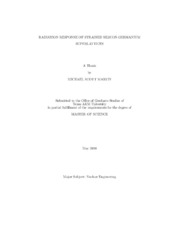| dc.description.abstract | The purpose of this study is to investigate the role of strain in the accumulation
of crystalline defects created by ion irradiation. Previous studies state that strained
Si1xGex is more easily amorphized by ion irradiation than unstrained, bulk Si in a
periodic superlattice structure; however, the reason for preferential amorphization of
the strained Si1xGex layer in the periodic structure of strained and unstrained layers
is not well understood.
In this study, various ion irradiations will be carried out on SiGe strained layer
superlattices grown on (100)-orientation bulk Si by low temperature molecular beam
epitaxy. The samples under investigation are 50 nm surface Si0:8Ge0:2/bulk Si and 50
nm surface Si/60 nm Si0:8Ge0:2/bulk Si.
Defects will be created in both surface and buried SiGe strained layers by medium
and high energy light ion irradiation. The amount of permanently displaced atoms
will be quantified by channeling Rutherford backscattering spectrometry. The amorphization model, the path to permanent damage creation, of bulk Si and surface
strained SiGe will be investigated. The strain in surface and buried Si0:8Ge0:2 layers
will be measured by comparison to bulk Si with Rutherford backscattering spectrometry by a novel technique, channeling analysis by multi-axial Rutherford backscatter-
ing spectrometry, and the limitations of measuring strain by this technique will be
explored.
Results of this study indicated that the amorphization model, the number of
ion collision cascades that must overlap to cause permanent damage, of strained Si0:8Ge0:2 is similar to that of bulk Si, suggesting that point defect recombination is
less efficient in strained Si0:8Ge0:2. Additionally, a surface strained Si0:8Ge0:2 is less
stable under ion irradiation than buried strained Si0:8Ge0:2. Repeated analysis by
multi-axial channeling Rutherford backscattering spectrometry, which requires high fluence of 2 MeV He ions, proved destructive to the surface strained Si0:8Ge0:2 layer. | en |


